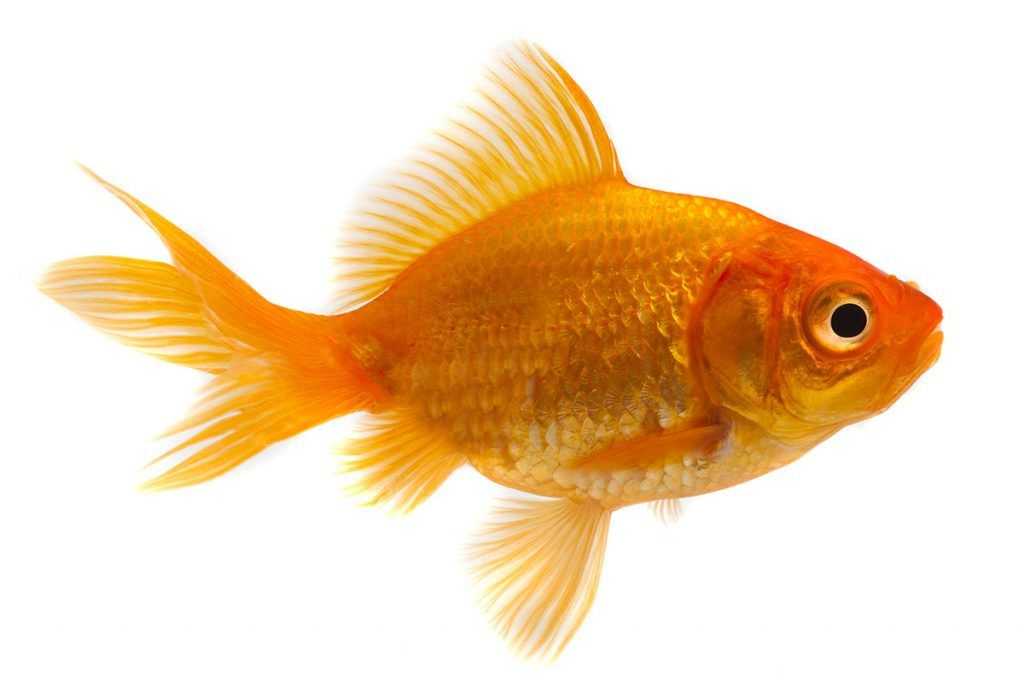Goldfish

Species Details
Carassius Auratus
Cyprinidae
Cypriniformes
Ponds, Lakes, Streams, Ditches
1 - 10 lbs.
1" - 19"
Goldfish (Carassius Auratus) Description
Goldfish are aptly named for their golden color. From their dorsal, they are bright orange before it changes into a more golden orange gradient heading down. Depending on the subspecies of Goldfish, it will have some distinct features. However, one of the most common features of a Goldfish is its forked tail. They have different fin configurations such as short or veil tail.
Goldfish were once thought to be a subspecies of carp. However, that was changed when Goldfish revealed that they had fewer lateral scales than carps. Unlike other fish, Goldfish are known for their color variety and are kept more as pets.
Goldfish Diet
Goldfish actually eat anything, ranging from bread, rice, bloodworms, and typical fish food. Goldfish breeders would sometimes feed their fish daphnia, crickets, mealworms, and shelled peas. Goldfish are not ideally picky but they’re always hungry, so constantly feeding them might be a bad idea.
Goldfish Size
Goldfish can reach an average length of 10 cm (inclusive of the tail). However, in bigger ponds and water bodies, Goldfish can hit around 48 cm and by a freak accident, can even hit up to one foot. However, this is assuming that they are in a big area. Goldfish are constantly growing and having a big water body will allow them to constantly expand.
Interesting Facts about the Goldfish
- Goldfish have different species types.
- Goldfish is more of an umbrella term. However, Goldfish breeders are more familiar with the breeds. Some of the breeds include the following:
- Oranda – This species is the poster fish for the Goldfish species. Most people come across Orandas because they have a combination of the Goldfish’s many desired aesthetics. They have a cap and a flowing tail and are usually colored orange. However, they also have a sub-specie which is known as the Red Cap. The Red Cap has a white body but its “cap” is bright red.
- Lionhead – An oblong-shaped Goldfish without a cap. The Lionhead is known as the ancestor to the Ranchu, the King of Goldfish. Its name comes from its hood which makes it look like it has a mane.
- Ranchu – The “King of Goldfish” and a Japanese strain of the Lionhead. They appear more egg-shaped and have a downturned fin and tail.
- Ryuukin – Another Japanese breed of Goldfish. These fish are known for two things: their large humpback and their prized flowing “veil” tail. They say that the longer the tail is, the stronger and more prized the bloodline. It also has two subspecies below it: the Tamasaba and Tosakin.
- Tamasaba – Its name was derived from its tail which reminded the Japanese of the mackerel fish (Saba meaning mackerel in Japanese). It is also known as the Yamagata Goldfish for being discovered in the Yamagata prefecture.
- Tosakin – These fish were bred by samurai years ago. They are known more as “top view” fish. These are the kind of fish that are admired from the top view. Its main feature is that its fantail spreads flat which may make it a clumsy swimmer.
- Veiltail – This is a hybrid between a Ryuukin and a Telescope Goldfish which resulted in a square-edged but long tail. A true Veiltail does not have forks in its tail. It is also known as the Philadelphia Veiltail.
- Pearl Scale – The Pearl Scale is aptly named as its scales appear protruded, creating an illusion that its scales are made of pearls.
- Telescope – The telescope species is known for its bulging eyes. They are commonly known as Moors. They come in orange color but the more expensive ones are the Black Moors. Or the Black Telescopes.
- Bubble Eye – This species of Goldfish has its eyes facing upward with two sacs that look like “bubbles” sitting underneath its eyes.
- Celestial Eye – The Celestial Eye Goldfish is known for its double tail and its bulging eyes facing upward.
- Shubunkin – Its name means “vermillion brocade” in Japanese. This is a cross between a common goldfish, a Calico Telescope Eye Goldfish, and a Comet Goldfish. It has a long body with a deeply forked tail which it inherited from the Comet Goldfish.
- Comet Goldfish – Slightly smaller and slimmer than your typical Goldfish, it’s more known for its deeply forked tail.
- Goldfish is more of an umbrella term. However, Goldfish breeders are more familiar with the breeds. Some of the breeds include the following:
- Goldfish are rumored to live up to 70 years.
- This depends however on the conditions.
- Goldfish are known for having breakages in their tail.
- Although they are considered freshwater fish, adding salt to the water helps them preserve their tail to prevent it from cracking.
- Goldfish are susceptible to swim bladder problems.
- Goldfish are inedible! They’re known to be poisonous.
Goldfish – Fishing Techniques: How to Fish for a Goldfish
Let’s face it, Goldfish are not the sharpest tool in the shed. Their brains are dictated by their stomachs. Also, they are prone to eating anything. Even as pets, these Goldfish are known to be gluttons. You, as the possible owner, will have to be the one to control their eating otherwise they’ll eat themselves to an explosion.
When baiting for a goldfish, some people have reported using bread or a single kernel of corn. Waxworms are a good idea also to attract them. Light tackle and equipment ought to do it. But anglers would also add that using a hook isn’t a good idea if you’re planning to breed and capture Goldfish for selling. You’re better off using a net.
Throw some bread and corn in the water and watch them come to you. Then, swoop in with a net and voila, you now have a Goldfish!
Goldfish Habitat and Distribution
Goldfish like rivers, ponds, or any body of water with slow-flowing or stagnant water. They also like water bodies that have a lot of vegetation and live better in cold water.







